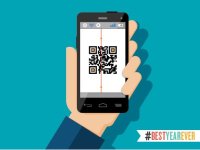Accessing Multimedia Using QR Codes
Your content has been saved!
Go to My Saved Content.Students of all ages are required to read text for a variety of purposes. With a large emphasis placed on teaching skills that help children tackle nonfiction, it's important to think about the different ways that students are gathering facts and details as they take in information. Teachers need to think beyond traditional text and make sure that their students have the necessary skills for processing, evaluating, and comprehending multimedia.
Not a Trend, But a Tool
Locating and sharing high quality multimedia content can be difficult. Even when you've found the perfect text to share with students, the next step can be logistically challenging. Getting articles, audio clips, images, and videos into the hands of your students is often easier said than done. I've shared the many reasons why I think QR (Quick Response) codes can make everyday classroom tasks simpler. When it comes to helping your students access multimedia in any form, try using QR codes to distribute the link and keep your classroom organized.
Many tech-enthusiastic educators have written off QR codes as a passing trend that can be replaced with augmented reality triggers. Scannable technology, especially augmented reality, is exciting and useful. It can be included in a variety of learning environments, and I encourage you to explore augmented reality and how it can be used with your students.
For teachers just getting started with technology, or those looking for flexibility in a BYOD (bring your own device) environment, QR codes still have an important place in a tech-friendly classroom. Students can use any device that has a QR code reader app to scan a teacher-created QR code and instantly view a hand-picked website. This is perfect in classrooms that have a mix of devices -- iPad, iPod Touch, webcam-enabled laptop -- and works well when teachers have to share devices with colleagues in their school. As long as their tablet or smartphone has a camera and a QR code reader app, students will be ready to scan the QR codes you've created and will be able to access multimedia text.
Curating and Sharing
Any multimedia found on the Internet can be linked to a QR code. Students can be sent to a specific YouTube or Vimeo clip using a link to that video. If teachers want their students to look at a primary source document, they can send them to a link connected to that image as opposed to a website that has a variety of pictures. This gives you the power to curate resources you've located on the Internet and even differentiate your instruction by sending different students or groups of students to multimedia that is connected to a leveled task.
Even though there are tons of great resources online to share with students, you might have an audio clip, movie file, or document that you want to place in their hands. File sharing services like Dropbox let users share files of any type through a URL or Web link. We often use this type of link to share a file with someone when it is too large to attach to an email. Another option that's perfect for the classroom is turning this link into a QR code so that students can scan the link and access any file a teacher has chosen for them. It's a great way to curate multimedia resources for your students, whether it's a current events article to read, a radio broadcast to listen to, or a news clip to watch.
Our students are digital natives, born in an age where they use Google at the library instead of searching through a card catalog. Teachers already know how to find the right resources for their students. Whether they are connecting multimedia to their curriculum or differentiating an assignment for groups, it's now easier than ever to put high-quality information in the hands of students. By attaching multimedia to a QR code, you can help students quickly access the perfect video, audio, or text using their mobile device.
